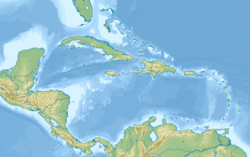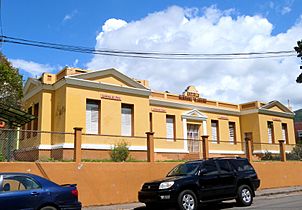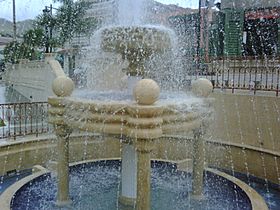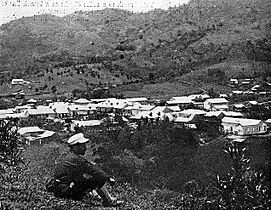Adjuntas barrio-pueblo facts for kids
Quick facts for kids
Adjuntas barrio-pueblo
Pueblo de Adjuntas
|
|
|---|---|
|
Municipality Seat
|
|
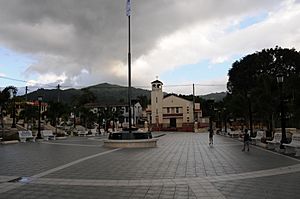
The central plaza with its church in 2008
|
|

Location of Adjuntas barrio-pueblo within the municipality of Adjuntas shown in red
|
|
| Commonwealth | |
| Municipality | |
| Area | |
| • Total | 0.75 sq mi (1.9 km2) |
| • Land | 0.75 sq mi (1.9 km2) |
| • Water | 0.00 sq mi (0 km2) |
| Elevation | 1,614 ft (492 m) |
| Population
(2010)
|
|
| • Total | 4,406 |
| • Density | 5,874.7/sq mi (2,268.2/km2) |
| Source: 2010 Census | |
| Time zone | UTC−4 (AST) |
| ZIP Codes |
00601, 00631
|
| Area code(s) | 787/939 |
Adjuntas barrio-pueblo is a special neighborhood in Puerto Rico. It is the main town and administrative center of the Adjuntas municipality. In 2010, about 4,406 people lived here.
Like many towns in Spain, and later in Puerto Rico, Adjuntas barrio-pueblo has a central square. This square is called a pueblo. It usually has the town hall, a Catholic church, and is a place for people to gather. Every year, the town celebrates Fiestas patronales, which are special festivals for the town's patron saint.
Contents
The Central Plaza and Its Church
The central plaza, or town square, is a lively place. People gather here for fun events and to socialize from morning until night. In the early 1800s, Spanish laws called the Laws of the Indies guided life in Puerto Rico. These laws said the plaza should be used for "parties" or celebrations. They also stated that the square should be big enough for all the people living nearby.
The Spanish rules also mentioned that streets near the plaza should have comfortable walkways. These walkways would protect people from the sun and rain.
Right across from the central plaza in Adjuntas barrio-pueblo is the Parroquia San Joaquín. This Roman Catholic church opened its doors in 1815.
History of Adjuntas Pueblo
The area where Adjuntas barrio-pueblo is today was first settled in the early 1800s. It was located in the Cidra River valley. An old road connected Utuado with Ponce and the southern coast of Puerto Rico. At that time, this area was part of the Coamo region.
A small chapel was built in 1805. Later, people in Adjuntas asked for it to become a larger parish church. The town was officially founded on August 11, 1815. Don Diego Maldonado was its official founder and first elected leader. In 1894, the Spanish crown gave Adjuntas the official status of a "villa," which meant it was an important town.
After the Spanish–American War, Spain gave Puerto Rico to the United States. This happened under the Treaty of Paris of 1898. Puerto Rico then became an unincorporated territory of the United States. In 1899, the U.S. government took a census of Puerto Rico. It found that the population of Adjuntas barrio-pueblo was 1,963 people.
Places to Visit
Adjuntas barrio-pueblo has several interesting spots.
- Adjuntas Public Square (Plaza Pública de Adjuntas) is in the very center of town. It is one of the highest plazas in Puerto Rico, almost 1,640 feet (500 meters) high. You can find a large working thermometer there. It reminds everyone of the coldest temperatures recorded in Puerto Rico. As is common in Puerto Rico, the plaza also has the town hall (alcaldía) and the Roman Catholic church (Parroquia San Joaquín).
- Casa Pueblo means "the people's house" in Spanish. It is a non-profit group that works to protect the environment. It is located in a historic Criollo house. Casa Pueblo often hosts cultural events, educational tours, and classes. This group played a big part in creating the nearby People's Forest (Bosque del Pueblo).
- The Washington Irving Grade School (Escuela Graduada Washington Irving) is a building listed on the National Register of Historic Places. It is located close to the town plaza.
Gallery
Places in Adjuntas barrio-pueblo:
-
Washington Irving School, listed on the US National Register of Historic Places
See also
 In Spanish: Adjuntas (Adjuntas) para niños
In Spanish: Adjuntas (Adjuntas) para niños
- List of communities in Puerto Rico


